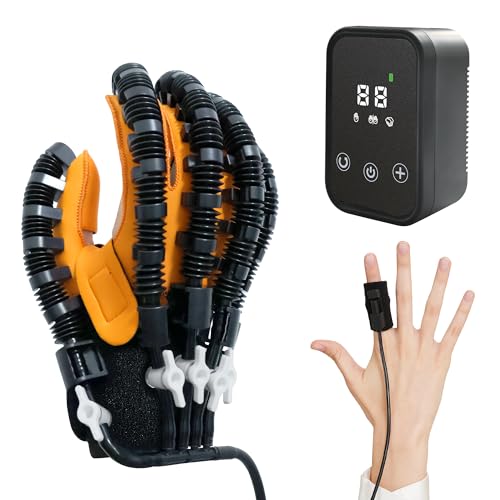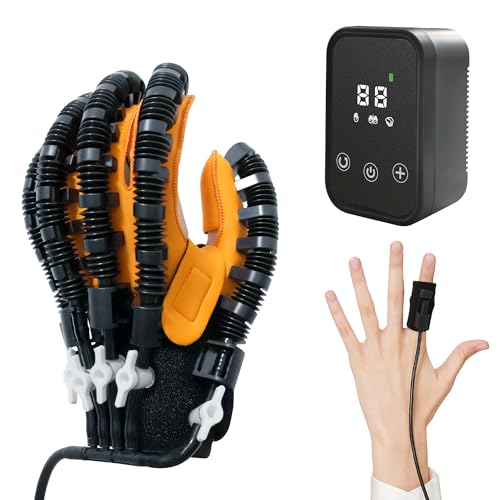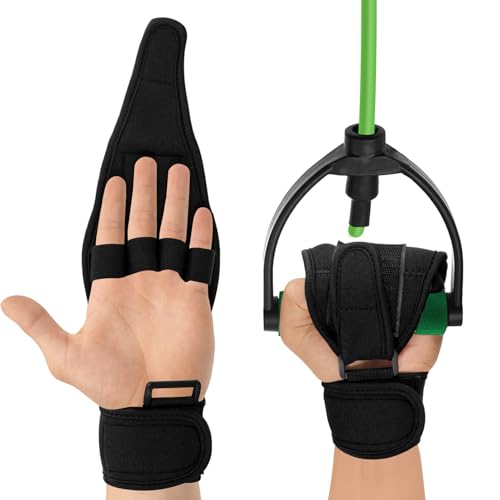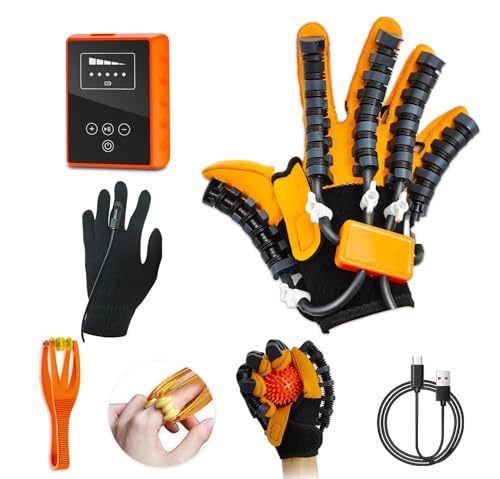If you’re looking for the best hand therapy devices to help stroke patients regain strength and mobility, I recommend starting with specialized gloves, robotic gloves, grip strength trainers, and finger splints. These tools support finger movement, reduce stiffness, and promote recovery through adjustable settings and user-friendly designs. Choosing the right device depends on the patient’s condition and recovery stage. Keep exploring options, and I’ll guide you through each one to find the perfect fit.
Key Takeaways
- Specialized rehabilitation gloves with adjustable air pressure, bionic modes, and mirror functions support neural retraining and hand mobility improvement.
- Rehabilitation robot gloves promote muscle activation, blood flow, and targeted finger exercises, aiding stroke recovery.
- Hand support devices like finger splint braces stabilize fingers while allowing movement, preventing further injury.
- Comprehensive exercise tools such as grip strength trainers and stress relief balls enhance grip strength and overall hand health.
- User-friendly, adjustable devices designed for home use help customize therapy, ensuring effective, gradual regain of hand strength and mobility.
Stroke Hand Rehabilitation Robot Gloves for Stroke Patients (Right M)
If you’re looking for an effective hand therapy device specifically designed for adult stroke patients, the Stroke Hand Rehabilitation Robot Gloves (Right M) stand out. Made from flexible polymers, these gloves fit comfortably and gently stretch fingers to promote recovery. They use air pressure to support finger flexion and extension, with adjustable speed and intensity across five levels. The automatic bionic training modes mimic natural gripping and stretching, stimulating brain activity. The mirror mode allows affected and healthy hands to synchronize, retraining neural pathways. Designed for comfort and effectiveness, these gloves help reduce stiffness, improve mobility, and support post-stroke rehabilitation.
Best For: adult stroke patients seeking comfortable, customizable hand rehabilitation to improve mobility and reduce stiffness post-stroke.
Pros:
- Adjustable speed and intensity levels for personalized therapy.
- Automatic bionic modes that mimic natural hand movements to stimulate brain activity.
- Comfortable fit with flexible polymers that gently stretch fingers during use.
Cons:
- May require professional guidance for optimal customization.
- Limited to hand rehabilitation, not suitable for full-arm recovery.
- Effectiveness depends on consistent use and patient adherence.
Roygra Grip Strength Trainer (8 Pack) for Hand and Wrist Exercise
The Roygra Grip Strength Trainer (8 Pack) is an excellent choice for stroke patients seeking a thorough hand and wrist rehabilitation tool. It includes a variety of devices like exercise balls, grip rings, and finger stretchers, all designed for extensive hand and finger training. Made from eco-friendly, durable silicone, these tools are safe, washable, and suitable for all ages and hand sizes. With adjustable resistance levels, they help increase grip strength, improve muscle balance, and enhance forearm development. Their portability makes them ideal for daily use at home or on the go, supporting recovery, stress relief, and overall hand health.
Best For: individuals seeking comprehensive hand and wrist rehabilitation, strength training, or stress relief across all ages and fitness levels.
Pros:
- Includes a variety of devices such as exercise balls, grip rings, and finger stretchers for full hand and finger training.
- Made from eco-friendly, durable, and washable silicone, ensuring safety and long-term use.
- Adjustable resistance levels allow for customized workouts suitable for beginners to advanced users.
Cons:
- Surface may be sticky initially, requiring rinsing to improve feel.
- Some users may find the multiple components cumbersome to store or carry separately.
- Resistance levels may not be sufficient for highly advanced users seeking maximal resistance.
Hand Grip Strengthener and Finger Exerciser for Therapy and Stress Relief
Hand grip strengtheners and finger exercisers are essential tools for stroke patients aiming to regain hand mobility and strength. They support recovery by improving finger flexibility, hand health, and muscle strength, making daily tasks easier. These devices also promote blood circulation through stimulating 3D spiky points, which helps reduce stiffness and relieves stress. Their ergonomic design keeps fingers secure, preventing injury or deformation. Made from skin-friendly, durable materials, they are safe and easy to use at home, work, or on the go. Whether for therapy, stress relief, or injury prevention, these exercisers are versatile, practical, and beneficial for overall hand wellness.
Best For: individuals recovering from hand injuries or surgeries, elderly users seeking hand health improvement, and stress relief enthusiasts seeking a portable, effective hand exerciser.
Pros:
- Supports recovery by increasing finger strength, flexibility, and hand health
- Stimulates blood flow and reduces stress through 3D spiky points
- Ergonomic design prevents finger injury and deformation while ensuring safety and comfort
Cons:
- May require consistent use over time to see significant strength improvements
- Some users might find the spiky points uncomfortable initially
- Not suitable for very severe hand injuries without professional guidance
Stroke Hand Rehabilitation Robot Gloves for Stroke Patients (Left L)
For stroke patients recovering from hemiplegia, the BLIUJQ Stroke Hand Rehabilitation Robot Gloves (Left L) offer targeted support through adjustable air pressure technology. Made from flexible polymers, these gloves guarantee a comfortable fit and secure hand positioning. They assist with finger stretching and grasping exercises, mimicking natural movements. With five adjustable levels of strength, speed, and intensity, they cater to individual needs. The gloves feature a mirror mode that allows the affected hand to follow the healthy hand, retraining the brain through repetitive motion. Regular use helps reduce stiffness, improve mobility, and accelerate recovery, making them an effective tool in all-encompassing hand rehabilitation.
Best For: stroke patients with hemiplegia seeking targeted, adjustable hand rehabilitation to improve mobility and reduce stiffness.
Pros:
- Supports both finger stretching and grasping exercises, mimicking natural hand movements.
- Adjustable settings with 5 levels of strength, speed, and intensity to personalize therapy.
- Features mirror mode to facilitate brain retraining through repetitive motion and active engagement.
Cons:
- May require initial guidance to properly adjust and operate the device effectively.
- Designed specifically for the left hand, limiting use for bilateral or right hand rehabilitation.
- Dependence on air pressure means occasional maintenance or troubleshooting may be necessary.
Hand Therapy Grip Ball for Hand Recovery and Stress Relief
Are you looking for a simple yet effective tool to aid in hand recovery and stress relief? The Hand Therapy Grip Ball is designed to help those with weak hands rebuild strength, regain mobility, and reduce stiffness. It’s ideal for stroke recovery, arthritis, carpal tunnel syndrome, or post-surgery rehab. Gentle squeezing improves circulation, alleviates pain, and prevents muscle atrophy. Plus, it serves as a stress-relief tool through rhythmic compression, easing anxiety and boosting focus. Made from soft, high-quality silicone, it’s comfortable and easy to use. Whether for seniors, musicians, or office workers, this grip ball supports daily hand exercises and mental relaxation.
Best For: individuals recovering from hand injuries, seniors seeking to maintain grip strength, and anyone looking to reduce stress and improve hand mobility through gentle exercises.
Pros:
- Supports hand recovery, mobility, and strength rebuilding for various conditions like arthritis and post-surgery
- Made from soft, high-quality silicone that is comfortable, easy to clean, and suitable for daily use
- Acts as a stress-relief tool, helping to alleviate anxiety and improve focus during work or study sessions
Cons:
- May provide limited resistance for advanced strength training or heavy-duty exercises
- Some users might find the size or resistance level less challenging if seeking more intense workouts
- Not suitable for individuals with severe hand injuries requiring specialized therapy equipment
Stroke Hand Rehabilitation Robot Gloves for Adults
Stroke Hand Rehabilitation Robot Gloves are an excellent choice for adult patients seeking effective, technology-driven hand recovery. Made from flexible polymers, these gloves comfortably fit and gently stretch fingers to promote healing. They use air pressure to mimic natural movements like grabbing and stretching, aiding brain retraining through repetitive exercises. With adjustable settings, users can customize intensity and speed, targeting specific fingers or full hand motion. The mirror mode allows affected hands to follow healthy movements, enhancing neural reactivation. Powered by bionic technology, these gloves help reduce stiffness, improve flexibility, and restore hand function efficiently, supporting extensive stroke rehabilitation and independence.
Best For: adults recovering from stroke seeking effective, technology-assisted hand rehabilitation to improve mobility and reduce stiffness.
Pros:
- Utilizes air pressure and bionic technology to mimic natural hand movements, enhancing recovery.
- Adjustable settings for personalized intensity, speed, and targeted finger training.
- Mirror mode facilitates neural retraining by enabling affected hands to follow healthy hand movements.
Cons:
- May require professional guidance to optimize training settings for individual needs.
- Potentially uncomfortable if not fitted properly, especially for sensitive skin.
- Cost can be high depending on the model and features, which might limit accessibility for some users.
Rehabilitation Robot Glove for Stroke, Robotic Hand Recovery Device
The Rehabilitation Robot Glove stands out as an ideal choice for patients seeking targeted, customizable hand therapy. It uses air pressure to gently open and close injured fingers, boosting muscle activity and blood flow. With nine adjustable strength levels, it adapts to each patient’s needs, simulating movements like grasping, stretching, and flexing to speed recovery. The glove features mirror mode, allowing the healthy hand to guide the affected one, and independent air valves for finger-specific training. This innovative device promotes muscle strength, reduces stiffness, and stimulates brain activity, helping patients regain hand function more effectively and comfortably.
Best For: patients recovering from stroke or experiencing hand muscle weakness, stiffness, or paralysis seeking targeted, adjustable, and comfortable hand rehabilitation therapy.
Pros:
- Customizable with nine strength levels to suit individual recovery needs
- Features finger-specific air valves for targeted training and flexibility
- Incorporates mirror mode to enhance guided, symmetrical rehabilitation
Cons:
- May require initial training to effectively utilize all adjustable features
- The device could be bulky or uncomfortable during prolonged use
- Dependence on air pressure might limit mobility in certain environments
Stroke Finger Splint Brace for Hand Therapy and Rehabilitation
For stroke patients experiencing hand weakness or paralysis, the Finger Splint Brace offers targeted support and stability. Made from high-quality, soft, skin-friendly fabric, it guarantees comfort during long-term use. The design stabilizes weakened or injured fingers while allowing a full range of motion, helping improve grip strength and hand function. Its anti-slip features, including five-finger separation and hook-and-loop fasteners, prevent finger spasms and slippage, especially of the thumb. Easy to put on and adjust with magic tape, it’s suitable for daily therapy at home or on the go. This durable brace is ideal for hemiplegia, elderly stiff hands, and safe training needs.
Best For: Stroke patients with hand weakness, paralysis, or recovering from finger injuries seeking comfortable, supportive hand therapy aid.
Pros:
- Made of high-quality, skin-friendly fabric ensuring comfort and durability
- Features anti-slip design with five-finger separation and adjustable hook-and-loop fasteners for enhanced grip and stability
- Easy to put on, remove, and adjust with magic tape, suitable for daily use and therapy sessions
Cons:
- May require initial adjustment to find the optimal fit for individual needs
- Limited size options may not suit all hand sizes perfectly
- Not suitable for users needing rigid immobilization or extensive finger immobilization
Rehabilitation Robot Glove for Stroke Recovery Device for Hemiplegia
A rehabilitation robot glove with independent air valves for each finger stands out as an ideal choice for patients seeking targeted hand recovery. It uses air pressure to move fingers—opening, closing, grasping, and stretching—boosting muscle activity and blood flow. With nine adjustable strength levels and intelligent movement imitation, it accelerates healing. The mirror mode allows the healthy hand to guide the injured one, customizing exercises. The independent valves enable precise, finger-specific training, essential for rebuilding strength and flexibility. This glove’s automatic, bionic technology stimulates brain activity, reduces stiffness, and alleviates discomfort, making it a versatile tool for stroke, hemiplegia, arthritis, and post-surgical recovery.
Best For: patients recovering from stroke, hemiplegia, arthritis, or finger stiffness seeking targeted, adjustable, and intelligent hand rehabilitation.
Pros:
- Offers independent air valves for precise, finger-specific training to rebuild strength and flexibility.
- Incorporates intelligent movement imitation and mirror mode for personalized, effective therapy.
- Uses automatic bionic technology to stimulate brain activity, reduce stiffness, and alleviate discomfort.
Cons:
- May require initial adjustment to find the optimal pressure and training mode for individual needs.
- The complexity of features could necessitate professional guidance for optimal use.
- Battery life or power source limitations might restrict continuous use during extended therapy sessions.
TYYIHUA Hand Contracture Cushions Palm Grip for Elderly
Designed specifically for elderly stroke patients, TYYIHUA Hand Contracture Cushions provide targeted support to prevent skin breakdown and improve hand safety. They feature an ergonomic palm grip with finger separators, reducing the risk of skin injuries and nail embedment. The elastic band ensures a secure fit for both hands, offering comfort during prolonged use. Made from breathable, moisture-absorbent materials, these cushions help relieve finger discomfort and support hand rehabilitation. They’re versatile and safe, making them ideal for addressing conditions like stroke recovery, hand weakness, or finger spasms. Overall, they promote mobility, comfort, and skin protection for elderly users.
Best For: elderly stroke patients and individuals undergoing hand rehabilitation seeking skin protection, comfort, and support during recovery.
Pros:
- Ergonomic design with finger separators to prevent skin breakdown and nail embedment
- Secure fit with elastic band suitable for various hand sizes
- Made from breathable, moisture-absorbent materials for enhanced comfort and skin health
Cons:
- Only includes one cushion, which may require purchasing multiple for bilateral use
- May take time to get accustomed to the finger separators during initial use
- Not adjustable beyond the elastic band, limiting customization for specific hand shapes
Rehabilitation Robotic Gloves for Stroke and Paralysis Recovery
Rehabilitation robotic gloves stand out as an ideal solution for stroke patients seeking independent hand recovery at home. These upgraded gloves are designed for adults with conditions like hemiplegia, cerebral palsy, or stroke-related paralysis, allowing self-directed therapy without frequent clinic visits. Made with durable nylon-enhanced materials and automotive-grade components, they offer a five-year lifespan with a three-year quality guarantee. The gloves support all-encompassing functions such as finger rotation, traction, muscle relaxation, and mirror training, all controlled via an intuitive interface. Easy to set up and operate, they help patients regain finger strength, improve mobility, and promote independence through effective, at-home rehabilitation.
Best For: adults with stroke, hemiplegia, cerebral palsy, or paralysis seeking effective, independent hand rehabilitation at home.
Pros:
- Durable nylon-enhanced construction with a 5-year lifespan and 3-year quality guarantee.
- Supports comprehensive functions including finger rotation, traction, muscle relaxation, and mirror training.
- Easy to set up and operate with intuitive controls, promoting self-directed therapy and independence.
Cons:
- May require initial training to fully utilize all advanced features and modes.
- Larger or bulkier design could be less portable for travel or outdoor use.
- Cost may be higher compared to basic rehabilitation devices due to advanced features and durable materials.
Rehabilitation Robot Gloves for Hand Recovery
Rehabilitation robot gloves excel for stroke patients seeking portable and customizable hand recovery solutions. These lightweight gloves, weighing only 0.3kg, are easy to carry and perfect for both indoor and outdoor exercises. They’re suitable for a variety of conditions, including hand injuries, nerve damage, arthritis, hemiplegia, and cerebral palsy. With adjustable training settings from 1 to 5, users can personalize the intensity of their sessions, which typically last up to 15 minutes. Equipped with adjustable strength support, USB charging, and hand function rehab features, these gloves promote effective recovery. Plus, dedicated 24/7 customer support guarantees prompt assistance, making them a reliable choice for ongoing therapy.
Best For: stroke patients and individuals with hand impairments seeking portable, customizable, and effective hand recovery exercises in any setting.
Pros:
- Lightweight and portable design for easy use indoors and outdoors
- Adjustable training intensity from 1 to 5 for personalized therapy
- Equipped with adjustable support, USB charging, and comprehensive hand rehab features
Cons:
- Limited session duration of up to 15 minutes may require multiple sessions for full recovery
- May require initial guidance to optimize adjustable settings for individual needs
- Potential dependency on customer support for troubleshooting technical issues
Rehabilitation Robot Gloves, Finger Exerciser for Stroke Recovery
If you’re seeking an effective way to regain hand function after a stroke, the Rehabilitation Robot Gloves stand out thanks to their advanced motorized exercises. Made of durable plastic and cloth, these gloves are designed for easy home use, featuring a user-friendly display interface, a side switch, and a plug-in function for extra power. They support finger rotation, extension, and bending, with options for sequential and mirror training. Offering five speeds and intensities, their powerful air pump and adjustable valve ensure safe, tailored therapy. Backed by years of expertise, these gloves promote recovery and improve hand mobility through precise, customizable exercises.
Best For: individuals recovering from stroke or suffering from hand and finger impairments such as arthritis, hemiplegia, or nerve injuries seeking effective, customizable home therapy.
Pros:
- Supports comprehensive finger exercises including rotation, extension, and bending for improved hand mobility.
- Features adjustable speeds and intensities, and a powerful air pump for safe, personalized training.
- User-friendly with a display interface, side switch, and plug-in function for added convenience and enhanced power.
Cons:
- May require initial setup and familiarization with the device’s controls and functions.
- As a specialized medical device, it might be costlier than basic rehabilitation tools.
- Limited to hand and finger training, not suitable for full-arm or gross motor rehabilitation.
Finger Orthotics, Extended Fingerboard Hand Splint for Rehabilitation
The Extended Fingerboard Hand Splint is an excellent choice for stroke patients who need targeted support to prevent finger flexion, spasms, and deformities. Made from durable ABS plastic with adjustable straps, it stabilizes fingers and reduces muscle tension. Its perforated design enhances comfort and ventilation, while the lightweight construction makes it portable for daily use. Wearing the splint for 20-30 minutes can help straighten fingers, relieve cramps, and support recovery. Ideal for individuals with neurological conditions like cerebral palsy, Parkinson’s, or nerve damage, it promotes better hand function and muscle control during rehabilitation. This splint offers effective, customizable support for diverse patient needs.
Best For: individuals recovering from neurological conditions such as stroke, cerebral palsy, Parkinson’s disease, or nerve damage who require finger stabilization and support during rehabilitation.
Pros:
- Durable ABS plastic construction ensures long-lasting use and stability
- Adjustable straps and perforated design provide a comfortable, customized fit and enhanced ventilation
- Lightweight and portable, suitable for daily activities and therapy sessions
Cons:
- May require proper fitting and adjustment for optimal effectiveness
- Designed primarily for rehabilitation, not for long-term continuous wear
- Limited to finger support; does not address overall hand or wrist mobility
KIKIGOAL Finger Splint Brace for Hand Training
The KIKIGOAL Finger Splint Brace stands out as an ideal choice for stroke patients who struggle with hand weakness or spasm, thanks to its adjustable anti-slip wrist and hand magic paste. Made from durable elastic cloth, it offers a customizable fit that guarantees comfort and security during use. Its five-finger separation design helps prevent spasms and improves grip stability, making it perfect for rehabilitation, strength training, and daily exercises. Suitable for various users, including those with hemiplegia or elderly individuals, this glove promotes hand mobility and muscle activation safely. Its versatile design supports safe, effective hand training for improved strength and function.
Best For: individuals recovering from stroke, elderly users with stiff hands, and those with hand weakness or spasms seeking safe, adjustable hand support for rehabilitation and strength training.
Pros:
- Adjustable anti-slip magic paste for a secure, customizable fit
- Five-finger separation design to prevent spasms and improve grip stability
- Made from durable, elastic cloth suitable for various rehabilitation and exercise routines
Cons:
- Includes only one glove, so users may need to purchase additional if both hands require support
- One-size-fits-all design may not provide perfect fit for very small or very large hands
- Not suitable for users seeking a finger-specific or more specialized splint
Factors to Consider When Choosing Hand Therapy Devices for Stroke Patients
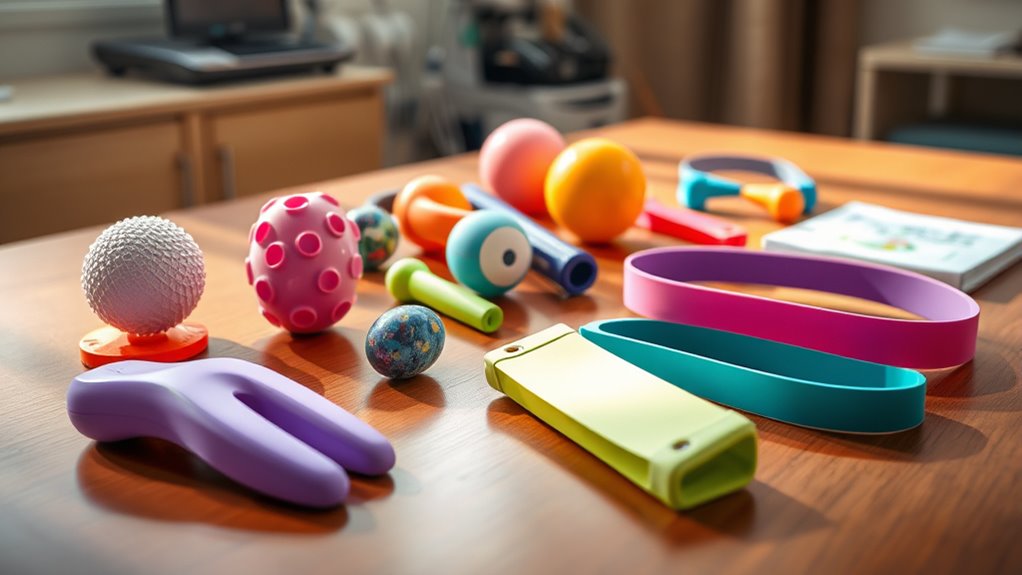
When selecting a hand therapy device for a stroke patient, I consider their specific hand condition and the device’s adjustability to match their needs. Ease of use and comfort are vital for consistent therapy, while ensuring the device aligns with their therapy goals helps maximize progress. Material safety also plays a role in making sure the device is both effective and comfortable for daily use.
Patient’s Hand Condition
Choosing the right hand therapy device for a stroke patient depends largely on the individual’s specific hand condition. I consider the severity of weakness or paralysis to determine if passive, assistive, or active devices are needed. When spasticity or muscle contractures are present, I look for tools that support stretching or splinting. The movements that require improvement—whether flexion, extension, or grasping—also shape my choice. I pay attention to the patient’s skin sensitivity and comfort, selecting materials that won’t cause irritation. Additionally, I assess the stage of recovery; in the acute phase, stimulation devices might be best, while in later stages, strengthening or mobility maintenance tools become more relevant. Tailoring devices to these factors ensures effective and comfortable therapy.
Device Adjustability Levels
Adjustability levels in hand therapy devices are vital because they allow me to customize therapy to each patient’s needs. Most devices offer multiple resistance or intensity levels, typically from 2 to 9, which helps tailor exercises to different recovery stages. Being able to modify speed and strength settings ensures therapy is appropriately challenging without causing discomfort. Fine-tuning movement ranges, like finger extension and flexion angles, enhances targeted treatment and prevents overexertion. Devices with adjustable features support gradual progression, making it safe for patients to increase difficulty as their hand function improves. This flexibility ensures therapy remains personalized, accommodating changing capabilities and recovery goals over time. Overall, adjustable settings are essential for optimizing outcomes and encouraging consistent progress.
Ease of Use
Selecting a hand therapy device that’s easy to use is essential, especially since many stroke patients have limited dexterity or cognitive challenges. I look for devices with simple, intuitive controls that don’t require complex操作. Adjustable settings are a plus, allowing me to personalize therapy and progress gradually. Lightweight and portable designs make it easier to practice at home or on the go, maintaining consistency. Clear instructions and user-friendly interfaces reduce the need for extensive training or supervision. Devices with automatic or guided exercises help minimize effort, so I can focus on my recovery without frustration. Overall, an easy-to-use device boosts confidence and encourages regular use, which is crucial for regaining strength and mobility in my hand.
Therapy Goals Alignment
Since every stroke patient’s recovery goals vary, it’s crucial to pick a hand therapy device that directly supports my specific mobility and strength needs. I look for devices that target my particular therapy objectives, such as improving grasping, stretching, or finger extension. Adjustable settings are essential, so I can match the device’s intensity to my progress and evolving goals. I also consider tools that include functional modes like mirror therapy or automatic bionic movements, which can boost neural recovery. The device’s design should facilitate goal-oriented exercises, helping me achieve measurable improvements in hand function. By aligning the device with my personalized therapy goals, I maximize my chances of regaining strength, dexterity, and independence efficiently.
Material Comfort & Safety
Choosing a hand therapy device that feels safe and comfortable is vital for effective recovery. I look for materials that are non-toxic, hypoallergenic, and gentle on the skin to prevent irritation or allergic reactions. Soft, breathable fabrics or flexible polymers ensure comfort during long therapy sessions, encouraging consistent use. Safety features like adjustable straps and secure fastenings are essential to prevent slipping, pinching, or constriction that could cause injury. I also prioritize devices made from durable, high-quality materials, which reduce the risk of breakage or deterioration over time, maintaining safety and reliability. When the device feels safe and comfortable, I’m more motivated to stick with my therapy routine, making progress toward regaining strength and mobility.
Portability & Convenience
Comfort and safety are important, but when it comes to staying consistent with hand therapy, portability and convenience can make all the difference. A lightweight device, ideally under 0.5kg, is much easier to use indoors and outdoors, encouraging more frequent practice. Compact designs with foldable features or small form factors allow for quick transportation and simple storage, so therapy fits seamlessly into daily life. Rechargeable batteries or USB charging options mean you don’t need to be near an outlet, making remote or mobile rehab more practical. Additionally, devices with intuitive controls and adjustable settings are user-friendly for patients and caregivers alike. Travel-friendly features like carrying cases or built-in compartments help keep everything organized, ensuring therapy remains accessible wherever and whenever it’s needed.
Durability & Quality
Durability and quality are essential factors when selecting hand therapy devices for stroke patients because they guarantee reliable performance over time. High-quality devices are crafted from durable, skin-friendly materials like silicone, TPR, or reinforced plastics that resist wear and tear through repeated use. Devices with adjustable settings and sturdy construction ensure consistent results and can adapt to changing patient needs. Features such as reinforced seams, secure fasteners, and reliable air valves help prevent leaks and mechanical failures, extending the device’s lifespan. Manufacturing standards like medical-grade certifications and strict quality control processes further ensure exceptional durability. Investing in well-made devices reduces the need for frequent replacements, offering long-term cost savings and dependable support during rehabilitation.
Support & Guidance
To guarantee effective rehabilitation, providing proper support and guidance when using hand therapy devices is crucial. Correct usage ensures maximum benefits and reduces the risk of injury or overexertion. I recommend choosing devices that come with clear instructions and educational resources so patients and caregivers can confidently operate them at home. Professional supervision is essential; healthcare providers can customize device settings and training routines to fit individual recovery needs. Ongoing guidance from medical professionals helps maintain adherence to therapy protocols and allows for progress tracking. Support systems, including responsive customer service and follow-up care, are also critical—they help address questions, troubleshoot issues, and keep motivation high throughout the rehabilitation journey. Proper support and guidance are key to successful recovery.
Frequently Asked Questions
How Do I Determine the Appropriate Hand Therapy Device for My Condition?
To find the right hand therapy device for your condition, I recommend consulting your healthcare provider first. They can assess your specific needs, severity, and goals. I also suggest researching devices designed for your level of mobility and strength, and reading reviews from other users. Trying out different options with professional guidance guarantees you select a device that’s safe, effective, and tailored to help you regain movement and confidence.
Are These Devices Suitable for All Stroke Severity Levels?
Oh, absolutely, these devices are perfectly suited for every stroke severity—just like a one-size-fits-all hat that magically fits everyone. In reality, their effectiveness varies. Mild strokes might find them helpful, but severe cases often need tailored therapy approaches. I recommend consulting a healthcare professional who can assess your specific needs and recommend the right device or therapy plan. Don’t assume one device fits all; personalized care makes all the difference.
Can Hand Therapy Devices Be Used at Home Without Supervision?
Yes, many hand therapy devices can be used at home without supervision, but it’s important to follow your healthcare provider’s instructions. I recommend starting with simple devices and gradually increasing intensity. Always guarantee you’re using proper technique to avoid injury. If you’re unsure, check in with your therapist regularly. Using devices correctly at home can support your recovery, but professional guidance ensures safety and ideal progress.
What Safety Precautions Should I Follow During Device Use?
Did you know that over 60% of stroke survivors experience hand weakness? When using therapy devices, I always follow safety precautions to prevent injury. I read the instructions carefully, start with low resistance, and avoid overexertion. I also make sure my hands are clean and free of cuts or infections before use. Listening to my body and stopping if I feel pain helps me stay safe and make the most of my recovery.
How Long Should Each Therapy Session With These Devices Last?
I recommend starting with 15 to 20-minute sessions, gradually increasing as your strength and comfort improve. It’s important not to overdo it, so listen to your body and take breaks when needed. Consistency is key, so aim for daily or every other day. Always follow your therapist’s guidance, and if you experience pain or discomfort, stop and consult your healthcare provider.
Conclusion
Choosing the right hand therapy device can truly make a difference in your recovery journey. But with so many options out there, how do you know which one will release your progress? The key lies in understanding your needs and finding that perfect fit. Stay tuned, because the device you pick might just be the game-changer you’ve been waiting for—ready to transform your recovery and surprise you in ways you never imagined.

